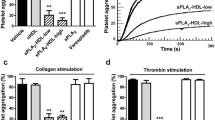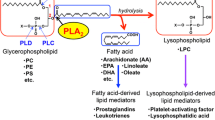Abstract
Secretory phospholipase A2 (sPLA2) represents a class of enzymes that hydrolyze phospholipids from cellular membranes and lipoproteins, resulting in multifarious proatherogenic actions in the vessel wall. Proatherogenic actions of sPLA2 involve lipoprotein remodeling that facilitates proteoglycan binding and formation of lipid aggregates that are rapidly internalized by tissue macrophages. The hydrolysis of phospholipids on cell membranes generates bioactive lipids and lipolipoproteins with increased oxidative susceptibility. These particles and other bioactive lipids activate inflammatory pathways in various cells of the vessel wall. Transgenic mice overexpressing groups IIA, V, and X have increased atherosclerosis formation, whereas mice deficient in these sPLA2 isoenzymes have less atherosclerosis formation. In apolipoprotein E knockout mice fed an atherosclerotic diet, sPLA2 inhibition with varespladib reduced atherosclerosis formation. The potential for sPLA2 inhibitors for preventing cardiovascular events is being investigated.
Similar content being viewed by others
References and Recommended Reading
Kimura-Matsumoto M, Ishikawa Y, Komiyama K, et al.: Expression of secretory phospholipase A2s in human atherosclerosis development. Atherosclerosis 2008, 196:81–91.
Lambeau G, Gelb MH: Biochemistry and physiology of mammalian secreted phospholipases A2. Annu Rev Biochem 2008, 77:495–520.
Burke J, Dennis E: Phospholipase A2 biochemistry. Cardiovasc Drugs Ther 2009, 23:49–59.
Gelb MH, Valentin E, Ghomashchi F, et al.: Cloning and recombinant expression of a structurally novel human secreted phospholipase A2. J Biol Chem 2000, 275:39823–39826.
Valentin E, Lambeau G: Increasing molecular diversity of secreted phospholipases A2 and their receptors and binding proteins. Biochimica et Biophysica Acta 2000, 1488:59–70.
Scott DL, White SP, Browning JL, et al.: Structures of free and inhibited human secretory phospholipase A2 from inflammatory exudate. Science 1991, 254:1007–1010.
Pan YH, Yu B-Z, Singer AG, et al.: Crystal structure of human group X secreted phospholipase A2. Electrostatically neutral interfacial binding surface targets zwitterionic membranes. J Biol Chem 2002, 277:29086–29093.
Tischfield JA, Xia YR, Shih DM, et al.: Low-molecularweight, calcium-dependent phospholipase A2 genes are linked and map to homologous chromosome regions in mouse and human. Genomics 1996, 32:328–333.
Ono T, Tojo H, Kuramitsu S, et al.: Purification and characterization of a membrane-associated phospholipase A2 from rat spleen. Its comparison with a cytosolic phospholipase A2 s-1. J Biol Chem 1988, 263:5732–5738.
Beers SA, Buckland AG, Koduri RS, et al.: The antibacterial properties of secreted phospholipases A2. A major physiological role for the group IIA enzyme that depends on the very high pi of the enzyme to allow penetration of the bacterial cell wall. J Biol Chem 2002, 277:1788–1793.
Bezzine S, Bollinger JG, Singer AG, et al.: On the binding preference of human groups IIA and X phospholipases A2 for membranes with anionic phospholipids. J Biol Chem 2002, 277:48523–48534.
Singer AG, Ghomashchi F, Le Calvez C, et al.: Interfacial kinetic and binding properties of the complete set of human and mouse groups i, II, V, X, and xii secreted phospholipases A2. J Biol Chem 2002, 277:48535–48549.
Ivandic B, Castellani LW, Wang XP, et al.: Role of group II secretory phospholipase A2 in atherosclerosis: 1. Increased atherogenesis and altered lipoproteins in transgenic mice expressing group IIa phospholipase A2. Arterioscler Thromb Vasc Biol 1999, 19:1284–1290.
Hanasaki K, Ono T, Saiga A, et al.: Purified group X secretory phospholipase A2 induced prominent release of arachidonic acid from human myeloid leukemia cells. J Biol Chem 1999, 274:34203–34211.
Tietge UJ, Maugeais C, Cain W, et al.: Overexpression of secretory phospholipase A2 causes rapid catabolism and altered tissue uptake of high density lipoprotein cholesteryl ester and apolipoprotein A-I. J Biol Chem 2000, 275:10077–10084.
Higashino K-I, Yokota Y, Ono T, et al.: Identification of a soluble form phospholipase A2 receptor as a circulating endogenous inhibitor for secretory phospholipase A2. J Biol Chem 2002, 277:13583–13588.
Hurt-Camejo E, Camejo G: Potential involvement of type II phospholipase A2 in atherosclerosis. Atherosclerosis 1997, 132:1–8.
Hurt-Camejo E, Andersen S, Standal R, et al.: Localization of nonpancreatic secretory phospholipase A2 in normal and atherosclerotic arteries: Activity of the isolated enzyme on low-density lipoproteins. Arterioscler Thromb Vasc Biol 1997, 17:300–309.
Wooton-Kee CR, Boyanovsky BB, Nasser MS, et al.: Group V sPLA2 hydrolysis of low-density lipoprotein results in spontaneous particle aggregation and promotes macrophage foam cell formation. Arterioscler Thromb Vasc Biol 2004, 24:762–767.
Flood C, Gustafsson M, Pitas RE, et al.: Molecular mechanism for changes in proteoglycan binding on compositional changes of the core and the surface of low-density lipoproteincontaining human apolipoprotein B100. Arterioscler Thromb Vasc Biol 2004, 24:564–570.
Sartipy P, Camejo G, Svensson L et al.: Phospholipase A2 modification of low density lipoproteins forms small high density particles with increased affinity for proteoglycans and glycosaminoglycans. J Biol Chem 1999, 274:25913–25920.
Hakala JK, Oorni K, Pentikainen MO, et al.: Lipolysis of LDL by human secretory phospholipase A2 induces particle fusion and enhances the retention of LDL to human aortic proteoglycans. Arterioscler Thromb Vasc Biol 2001, 21:1053–1058.
Sartipy P, Johansen B, Gasvik K, et al.: Molecular basis for the association of group IIA phospholipase A2 and decorin in human atherosclerotic lesions. Circ Res 2000, 86:707–714.
Murakami M, Kambe T, Shimbara S, et al.: Functional association of type IIA secretory phospholipase A2 with the glycosylphosphatidylinositol-anchored heparan sulfate proteoglycan in the cyclooxygenase-2-mediated delayed prostanoid-biosynthetic pathway. J Biol Chem 1999, 274:29927–29936.
Kleinman Y, Krul ES, Burnes M, et al.: Lipolysis of LDL with phospholipase A2 alters the expression of selected ApoB-100 epitopes and the interaction of LDL with cells. J Lipid Res 1988, 29:729–743.
Gorshkova IN, Menschikowski M, Jaross W: Alterations in the physiochemical characteristics of low and high density lipoproteins after lipolysis with phospholipase A2. A spin-label study. Biochimica et Biophysica Acta 1996, 1300:103–113.
Tietge UJF, Pratico D, Ding T, et al.: Macrophage-specific expression of group IIA sPLA2 results in accelerated atherogenesis by increasing oxidative stress. J Lipid Res 2005, 46:1604–1614.
Rosengren B, Peilot H, Umaerus M, et al.: Secretory phospholipase A2 group V: Lesion distribution, activation by arterial proteoglycans, and induction in aorta by a western diet. Arterioscler Thromb Vasc Biol 2006, 26:1579–1585.
Karabina SA, Brocheriou I, Le Naour G, et al.: Atherogenic properties of LDL particles modified by human group X secreted phospholipase A2 on human endothelial cell function. FASEB J 2006, 20:2547–2549.
Gesquiere L, Cho W, Subbaiah PV: Role of group IIa and group V secretory phospholipases A2 in the metabolism of lipoproteins. Substrate specificities of the enzymes and the regulation of their activities by sphingomyelin. Biochemistry 2002, 41:4911–4920.
Hanasaki K, Yamada K, Yamamoto S, et al.: Potent modification of low density lipoprotein by group X secretory phospholipase A2 is linked to macrophage foam cell formation. J Biol Chem 2002, 277:29116–29124.
Leitinger N, Watson AD, Hama SY, et al.: Role of group II secretory phospholipase A2 in atherosclerosis: 2. Potential involvement of biologically active oxidized phospholipids. Arterioscler Thromb Vasc Biol 1999, 19:1291–1298.
Bhattacharyya T, Nicholls SJ, Topol EJ, et al.: Relationship of paraoxonase 1 (pon1) gene polymorphisms and functional activity with systemic oxidative stress and cardiovascular risk. JAMA 2008, 299:1265–1276.
Menschikowski M, Hagelgans A, Heyne B, et al.: Statins potentiate the IFN-[gamma]-induced upregulation of group IIA phospholipase A2 in human aortic smooth muscle cells and hepg2 hepatoma cells. Biochimica et Biophysica Acta 2005, 1733:157–171.
Menschikowski M, Hagelgans A, Hempel U, et al.: Glycogen synthase kinase-3[beta] negatively regulates group IIA phospholipase A2 expression in human aortic smooth muscle and hepg2 hepatoma cells. FEBS Lett 2004, 577:81–86.
Park D-W, Kim JR, Kim SY, et al.: Akt as a mediator of secretory phospholipase A2 receptor-involved inducible nitric oxide synthase expression. J Immunol 2003, 170:2093–2099.
Balboa MA, Balsinde J, Winstead MV, et al.: Novel group V phospholipase A2 involved in arachidonic acid mobilization in murine P388D1 macrophages. J Biol Chem 1996, 271:32381–32384.
Kim YJ, Kim KP, Han SK, et al.: Group V phospholipase A2 induces leukotriene biosynthesis in human neutrophils through the activation of group IVA phospholipase A2. J Biol Chem 2002, 277:36479–36488.
Henderson WR Jr, Chi EY, Bollinger JG, et al.: Importance of group X-secreted phospholipase A2 in allergen-induced airway inflammation and remodeling in a mouse asthma model. J Exp Med 2007, 204:865–877.
Saiga A, Uozumi N, Ono T, et al.: Group X secretory phospholipases A2 can induce arachidonic acid release and eicosanoid production without activation of cytosolic phospholipase A2 alpha. Prostaglandins Other Lipid Mediat 2005, 75:79–89.
Bezzine S, Koduri RS, Valentin E, et al.: Exogenously added human group X secreted phospholipase A(2) but not the group IB, IIA, and V enzymes efficiently release arachidonic acid from adherent mammalian cells. J Biol Chem 2000, 275:3179–3191.
Boilard E, Bourgoin SG, Bernatchez C, et al.: Interaction of low molecular weight group IIA phospholipase A2 with apoptotic human t cells: Role of heparan sulfate proteoglycans. FASEB J 2003, 17:1068–1080.
Saegusa J, Akakura N, Wu CY, et al.: Pro-inflammatory secretory phospholipase A2 type IIA binds to integrins {alpha}v{beta}3 and {alpha}4ta1 and induces proliferation of monocytic cells in an integrin-dependent manner. J Biol Chem 2008, 283:26107–26115.
Antonov AS, Kolodgie FD, Munn DH, et al.: Regulation of macrophage foam cell formation by {alpha}V{beta}3 integrin: potential role in human atherosclerosis. Am J Pathol 2004, 165:247–258.
Bostrom MA, Boyanovsky BB, Jordan CT, et al.: Group V secretory phospholipase A2 promotes atherosclerosis: Evidence from genetically altered mice. Arterioscler Thromb Vasc Biol 2007, 27:600–606.
Hurt-Camejo E, Olsson U, Wiklund O, et al.: Cellular consequences of the association of ApoB lipoproteins with proteoglycans. Potential contribution to atherogenesis. Arterioscler Thromb Vasc Biol 1997, 17:1011–1017.
Ishimoto Y, Yamada K, Yamamoto S, et al.: Group V and X secretory phospholipase A2s-induced modification of high-density lipoprotein linked to the reduction of its antiatherogenic functions. Biochimica et Biophysica Acta 2003, 1642:129–138.
Webb NR, Bostrom MA, Szilvassy SJ, et al.: Macrophageexpressed group IIA secretory phospholipase A2 increases atherosclerotic lesion formation in LDL receptor-deficient mice. Arterioscler Thromb Vasc Biol 2003, 23:263–268.
Boyanovsky B, Webb N: Biology of secretory phospholipase A2. Cardiovasc Drugs Ther 2009, 23:61–72.
Boyanovsky BB, van der Westhuyzen DR, Webb NR: Group V secretory phospholipase A2-modified low density lipoprotein promotes foam cell formation by a SR-A- and CD36-independent process that involves cellular proteoglycans. J Biol Chem 2005, 280:32746–32752.
Fraser H, Hislop C, Christie RM, et al.: Varespladib (A-002), a secretory phospholipase A2 inhibitor, reduces atherosclerosis and aneurysm formation in ApoE-/- mice. J Cardiovasc Pharmacol 2009, 53:60–65.
Shaposhnik Z, Wang X, Trias J, et al.: The synergistic inhibition of atherogenesis in ApoE-/- mice between pravastatin and the sPLA2 inhibitor varespladib (A-002). J Lipid Res 2008, 50:623–629.
Rosenson RS, Hislop C, McConnell D, et al.: Effects of a selective inhibitor of secretory phospholipase A2 on low density lipoproteins and inflammatory pathways. Lancet 2009, 373:649–658.
Author information
Authors and Affiliations
Corresponding author
Rights and permissions
About this article
Cite this article
Rosenson, R.S., Gelb, M.H. Secretory phospholipase A2: A multifaceted family of proatherogenic enzymes. Curr Cardiol Rep 11, 445–451 (2009). https://doi.org/10.1007/s11886-009-0064-2
Published:
Issue Date:
DOI: https://doi.org/10.1007/s11886-009-0064-2




